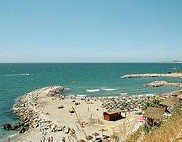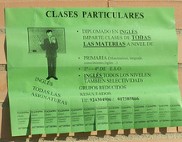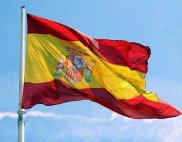

Differences Between the North and South of Spain
All of Spain is not the same. Like many countries, there are regional differences as far as food, customs, language, tourism and industry are concerned. Some folks prefer the easy going south, while others tend to favor the more industrial and commercially minded north. Let’s take a look, using broad strokes, at some of the differences between the different parts of Spain.
The south is a heck of a lot hotter than the north, and is famed for its Mediterranean beaches, dry weather, tapas, and flamenco. When you get up into the north, and some of the more mountainous areas of Spain, you’ll come across a wilder beauty, colder weather, and a lot more rain. Here you have the Death Coast (Costa da Morte) on the Atlantic Ocean, which can be battered by some pretty fierce storms, hence the scary name. The south has its storms too, but a lot more sun and heat.
The south has much more tourism than the north. People from all over Europe come here to buy houses and apartments, holiday homes, or to retire. They want to take full advantage of the sun in places like Costa del Sol. The north has pristine beaches as well, and in some ways they are more untouched that in the south, but they don’t get nearly as much light, and for this reason, most of Spain’s foreign guests flock to the south.
Since the south gobbles up most of the tourist trade, the north relies on other industries, like mining, ship building and manufacturing. As far as cuisine goes, the north tends to have heartier food than the south, where seafood reigns supreme. Some people believe southerners are a bit friendlier than the northerners. Perhaps it’s because southerners get a lot more sun. Regardless, every part of Spain has something unique to offer, from great food and wonderful wines, to local traditions, dances and architectural monuments. At least now you know a little more about some or the general differences between the north and the south of Spain. Hopefully, you’ll get to see it all.

Teaching English in Spain
If you want to teach English in Spain, and you are a native speaker of the English language, your overall experience in this great country will depend a lot on where you come from. The Spanish are famed for not being able to speak foreign languages well, but there are plenty of students in the country trying to change that. There are tons of language schools spread out all over the country. Native speaking English teachers are sought after, but there is a catch… Most schools really only want to hire people from EU countries, meaning that they want you to already be legal to work in Spain. So, if you come from the UK, and you have some basic teaching credentials like a TESL, ESL or CELTA certificate, you’re all set. Finding a job should be pretty easy.
Problems arise for teachers from non-EU countries (Australia, Canada, New Zealand, the USA), due to the fact that getting a working visa for Spain can be pretty tough. While the demand is there, the bureaucracy in place often proves to be a huge headache for teachers who come from outside of Europe.
But don’t lose hope. Americans and Australians can find work in Spain. It will simply be a lot more difficult. Getting a school to sponsor you, when the school can just hire someone from England or Ireland (who doesn’t need sponsorship) can be tricky at times. If you have an ‘in’ at some teaching institution, don’t be shy about using it. It is possible to work without papers, or ‘under the table,’ but that experience can be hit and miss. While you won’t be paying taxes, you won’t get any benefits (social security) or have any legal rights, should an employer withhold pay or cheat you in any way.
Some language schools prefer American English, so if you want to work legally in Spain, you need to develop some kind of relationship with those schools, and hopefully they will sponsor your working papers.
There are a lot of pros and cons to the teaching English in Spain, which vary, depending on where you come from, and how long you plan to stay. Once you overcome the potential hurdles in your way, it can also be a very rewarding profession, and a great way to make a living (although a modest one) in Spain.

The Love of Paella
Maybe you’re an expert on Paella, maybe not. It doesn’t matter either way, because if you aren’t hooked on this staple of Spanish cooking already, you soon will be.
So, what is Paella exactly? Paella is a well-known Valencian rice dish that makes use of different kinds of meat, like chicken and rabbit, plus lots of vegetables. Sausages and different kinds of chorizo can also be included, and of course you shouldn’t forget the rice, which cradles the meat and the vegetables.
All right, now you have some idea of what Paella is, as far as the basics go. Just to make sure you are well versed on the subject, you should know that there are different kinds of paella out there as well. Mixed paella, which is made up of seafood and meat, and pure seafood paella can be ordered and enjoyed in many parts of Spain.
This hearty dish really is a delight, and is one of the Spanish foods, along with chorizo sausages, that have gained immense popularity outside of Spain. Paella originated as a meal for workers who were out in the fields toiling away. It was pretty easy to make, and animals like rabbits and snails were easy to find and add to the mix. The great thing about paella back in the day was how community oriented the preparation and consumption of the rice, meat and vegetables was. Everyone could just sit around the giant paella pan, and scoop the food up with their spoons once the meat had been thoroughly cooked.
For those of you who are not in Spain, you can try to make paella at home on your own. If you can’t get hold of traditional paella pan, then grab the biggest fry pan you can find. It won’t be as good, but it will have to do. There are all kinds of recipes out there for different types of paella. Surf the Internet and you’ll be inundated with ideas, or check back here for our own paella recipe, which you can try out for yourself. Buen provecho! Buen apetito!

Bicycles Beat Cars in Barcelona
If you happen to live in Barcelona, or you are just passing through for a visit, you should really take advantage of the flat streets and ride a bicycle. Okay, once you get away from the downtown area, and head up into the northern part of the city, you’ll encounter some hills, but they’re nothing to worry about. With the exception of Park Güell, most of the notable spots you’ll want to hit are down in the flats. And the great thing about Barcelona, we’ve found out, is that there are tons of bikes on offer.
Aside from the normal rental shops that cater to tourists, the city also offers the ‘bicing’ city bicycle borrow/rental program. Once you get a bicing card, you can check bikes out from automated rental stations located all over the city, ride them around, and then check them back in at the station closest to where you finished your ride. A lot of locals use this service for short and medium commutes, and tourists who frequent the city take advantage of it too.
It’s really a great idea, because it will let you see the city in a way you won’t get by taking the metro, taxis or even the buses. There are tons of cool alleys and side streets spread out all over Barcelona. A bicycle will let you explore them all. Besides the ease with which you can get about, if you opt for two-wheeled transport, you’ll also be doing the environment a favor, and reducing pollution in the Catalan capital. Barcelona is a big city, with a lot going on, but traffic can became very congested. The more people who choose to see the marvels here by bike, the cleaner the streets and the air will become.
If you’re interested in ‘bicing,’ you can read more about it here (in Spanish):
www.bicing.cat
For those of you who aren’t up on your Spanish, tourist offices, hostels and hotels can help you set up a bicing card, or point you in the direction of a traditional bicycle rental shop. Happy trails!

The Advantages of Knowing Spanish in Spain
Spanish is one of the most widely spoken languages in the world. If you are an Anglophone (meaning English is your mother tongue), and you travel a lot, you are probably used to just about everyone being able to speak at least a smidgen of English.
Welcome to Spain! Just like the Americans, the English and the French, the Spanish are renowned for not really being able to speak other languages very well. Of course there are regional languages, like Catalan and Gallego, which some people know. And the folks living along the French border tend to speak a bit of French, but by and large, in Spain, you need to speak Spanish if you intend on getting anything done.
Outside of the hospitality industry, you’ll find life can be pretty difficult if you don’t have a rudimentary command of Spanish. Clerks and functionaries working in offices and government agencies will fire a string of Castilian Spanish at you when you show up with a problem or a request. You can ways try the old, “No hablo español. Hable más lento, por favor.” You’ll be surprised by how far that usually gets you, because it doesn’t get you very far. If you’re luck, the person you’re speaking with might throw in a few words of English, but more likely than not, he or she will just repeat what was already said to you in Spanish, only at twice the volume.
Besides dealing with the day-to-day necessities of life, some command of Spanish will let you integrate into the community better, chat with locals at the taverns and restaurants, and soak up all the culture and life Spain has to offer. If you plan on spending an extended period of time in Spain, it’s just good manners to know some phrases in Spanish, and make an effort to use them when speaking with Spaniards. A little work on your part will let you reap tons of benefits down the road, make new friends, and learn about what’s cool and going on outside the worn and beaten path most tourists follow.
El español es fácil. Spanish isn’t that hard. After some study, and time with the locals drinking wine and eating tapas, the words will be flowing off your tongue.

How Spain is Different From Mexico
This post is geared more toward North Americans, who sometimes come to Spain and wonder where the tacos stands are. Sorry to disappoint you, but Spain is not the land of tacos and burritos. That would be Mexico. While there are similarities between the two countries (they share a common language, after all), there are plenty of differences too.
For those of you who already know Spain, you don’t need to worry about these details. For those of you who aren’t as familiar, here’s a list to clue you in on some of the differences between the Mexicans and the Spanish.
1. Mexico is in Latin America, while Spain is in Europe, and is part of the European Union.
2. Spain is more industrialized than Mexico, and the rule of law is stronger there. Mexico is still in some ways a developing country, and beset with problems of violent crime, and powerful drug cartels. Spain’s problems are mostly economic these days.
3. Mexican Spanish has many more English words in it, as well as words that come from indigenous populations living in the Americas before the Europeans arrived, than Spanish from Spain.
4. Spanish food is considered a Mediterranean cuisine, with influences from the Middle East. Saffron, honey, and tons of garlic and olive oil are used extensively. In Mexico, beans and tortillas make up the foundations of the diet, and are consumed much more often then they are in Spain.
5. A lot of Mexican food can be eaten with your hands, like burritos and tacos. In Spain, meals are usually eaten with a knife, spoon and fork.
6. The population of Mexico is mostly mestizo, although there are many different ethnicities living inside of the country. Most Spaniards can trace their ancestry to the Mediterranean or Northern Europe, but of course immigration from other parts of the world has changed the mix some.
7. In Spain, for the most part, people speak a lot faster than they do Mexico, and faster than Latinos in general. There are also big differences in pronunciation. The consonants, like S and Z have a harder edge to them in Mexico, while in Spain they tend to be much softer when spoken aloud.



